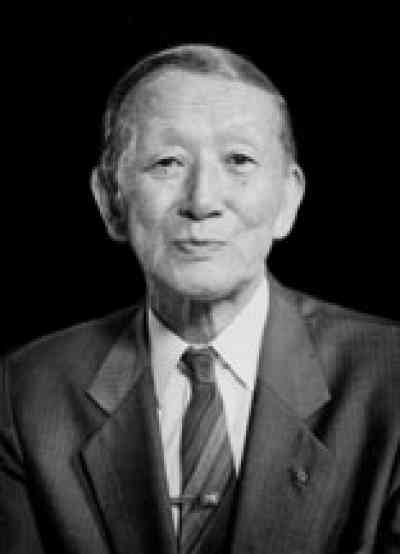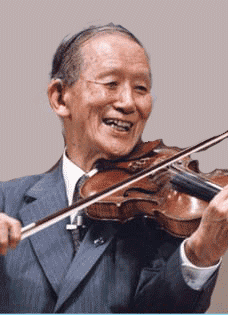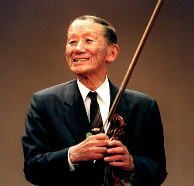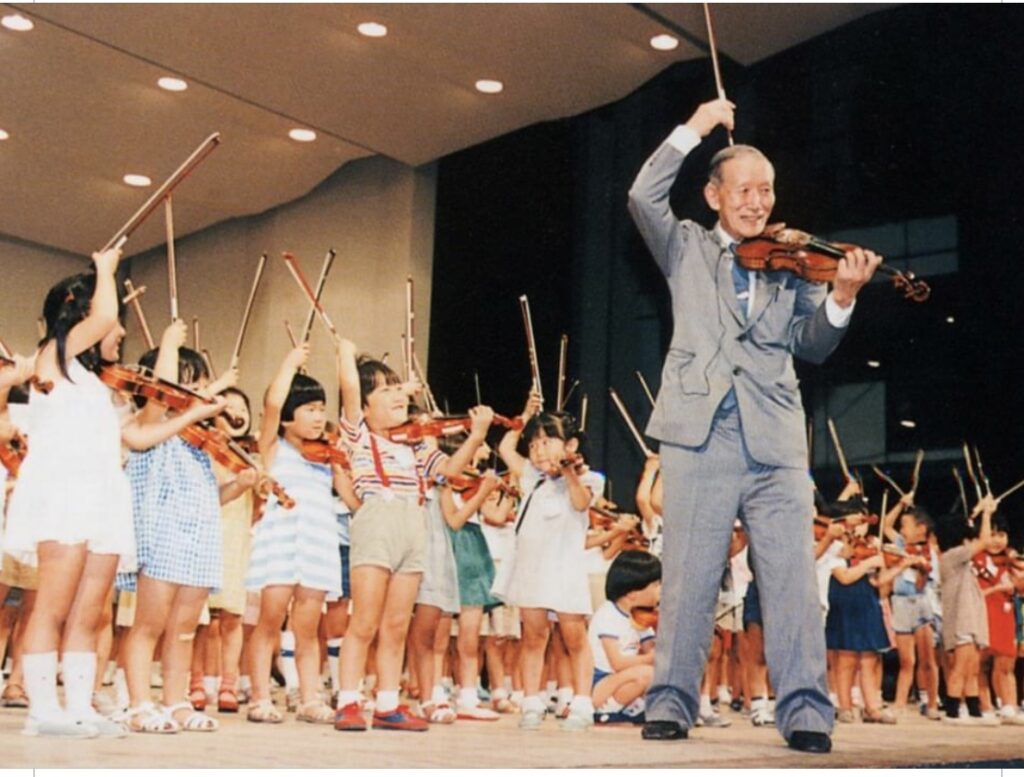Suzuki Method
About Dr. Suzuki himself:

Shinichi Suzuki, the man who developed the Suzuki Method, was born on October 17, 1898, in Nagoya, Japan. He was one of twelve children and his father owned a violin factory. Shinichi and his brothers and sisters played near the factory and saw instruments being made, but the children never realized what beautiful sounds could come from a violin. When he was seventeen, Shinichi heard a recording of Schubert’s Ave Maria, played by a famous violinist named Mischa Elman. He was amazed that a violin could make such a beautiful tone because he had thought it was just a toy!
After this, Shinichi brought a violin home from the factory and taught himself to play. He would listen to a recording and try to imitate what he heard. A few years later he took violin lessons from a teacher in Tokyo. Then, when he was 22 years old, he went to Germany and studied with a famous teacher named Karl Klingler. Shinichi also met his wife Waltraud in Germany. They married and moved back to Japan, where he began to teach violin and play string quartet concerts with his brothers.


Shinichi had always loved children and became very interested in teaching them. He thought that children could learn music just as they learned to speak—starting when they were very young and hearing music all around them. He believed that all children have the talent to learn if they are taught well by loving parents and teachers. These were very unusual ideas at that time. If children did play an instrument, they started learning when they were ten or eleven. Also, most people thought that musical talent was a special thing that only a few people had.
Dr. Suzuki’s young students learned to play very well and everyone was amazed when they performed. No one had ever seen so many young children playing music so beautifully. At first people thought all the students were musical geniuses. They did not understand Suzuki’s idea that all children can learn if they are taught in the right way.
For many years Dr. Suzuki continued to work on his teaching method. He chose music that would help children learn to play. He even wrote some pieces himself (like the Twinkle Variations, Allegro, Perpetual Motion, and Etude). Teachers from many countries came to Japan to learn about his method of teaching, and Dr. Suzuki and his students traveled to play in other countries. Over the years, more and more teachers and parents became interested in Suzuki’s ideas and began to teach children with his method. Now there are thousands of children around the world who have learned to play instruments through the Suzuki Method.
Through his teaching, Dr. Suzuki showed teachers and parents everywhere what children could do. He also believed that hearing and playing great music helped children become good people with beautiful, peaceful hearts. Dr. Suzuki hoped that these children would help bring peace and understanding to the world.
Dr. Suzuki died on January 26, 1998, at his home in Matsumoto, Japan. Though he lived to be 99 years old, Dr. Suzuki always seemed young. He was full of energy, and was cheerful and loving to everyone he met.
Dr. Suzuki Speaks to Children

For many years, Japanese children sent graduation tapes to Dr. Suzuki so he could hear their playing. He would listen and make comments to the children and then return the tapes to them.
Dr. Suzuki encouraged the children and made suggestions for them to improve their playing. But he also wanted children to develop beautiful hearts. He asked them not to hurt other people’s feelings and encouraged them to be kind to everyone—their friends, families, and teachers.
On one child’s tape, he said, “You are going to play the music of great composers, and you must try to catch their hearts in the music. You must practice every day to catch the feelings of others without words. Look at your mother and father. Can you see how they feel? Try to see when your mother needs your help before she asks. Then it is too late. If you practice every day, watching not to harm anyone by what you say, and also trying to catch how they feel, then you will develop sensitivity toward the feelings of others. Perhaps later you will also catch the hearts of Bach and Mozart in their music.”
Dr. Suzuki also made these suggestions to children at their lessons. He would ask them to do something special for a friend or someone in their family and tell him about it at the next lesson.
Sometimes children would be so excited to report their good deeds to Dr. Suzuki that they could hardly wait to tell him. After his ending bow, one little boy hurried to Dr. Suzuki to whisper, “I polished my father’s shoes without his knowing it!”
A Gift to Dr. Suzuki
A Japanese mother wrote letters to her daughters when they went with Dr. Suzuki on a trip to the United States. To her nine-year-old daughter Makiko, she said, “The teachers must be very busy during the tour. Is there anything you can do to help? It will be wonderful if you can be helpful and willing. Please show your care to everyone around you. For example, instead of serving yourself first at meals, you might serve the smaller children, your friends and the teachers, and then take your share.” And to five-year-old Emiko, she wrote, “The sound that comes dancing out of your violin—that is your heart, Emi. What kind of heart do you have, I wonder? From a beautiful heart comes a beautiful sound.”
On October 17 she wrote to the girls, “Today is Mr. Suzuki’s birthday. I am sure you celebrated and sang Happy Birthday. You have Mr. Suzuki’s poem which says: Wish for a beautiful tone for a beautiful heart. I think this is what Mr. Suzuki always thinks about through the violin. Today, how about giving him your tone, your heart for a present.”
Dr. Suzuki would be very happy to know that Suzuki children all over the world are learning to play music beautifully and to become kind, peaceful human beings. On his next anniversary of his birthday, October 17, please think of him, thanking him for his gifts to children and giving him your beautiful tone and heart in return.
About the Suzuki Method:
Dr. Shinichi Suzuki wanted to teach young children to play music using what he called the “Mother Tongue” method. He used the fundamentals of how a child learns their native language to teach violin to children as young as 2 and 3 years old. Later, his method expanded to include instruction for many other instruments including Suzuki Viola, Suzuki Cello, Suzuki Bass, Suzuki Piano, Suzuki Guitar and many more.
Dr. Suzuki’s philosophy of Talent Education is that talent is not inherited but taught and that any child can learn given the right environment and encouragement to do so.
Some of the key points of the Suzuki Method include:
- An early start ~ Children begin learning from the time they are born and can be introduced to music from the very start.
- Listening ~ Just as a child hears his/her mother speak even from the womb, listening is an integral part of learning. With the Suzuki Method, students listen regularly to the Suzuki CD’s as well as teachers, parents and other children playing their instrument.
- Imitation ~ How does a child learn to do something? By copying a person who is close to them. Teachers and Parents make excellent examples and children will begin to imitate what they see.
- Repetition ~ When you child spoke his first word he/she probably began to repeat it over and over “mama” “mama” “mama” until another word was learned and added to the vocabulary. It is the same with the Suzuki Method where repertoire is a vocabulary of music.
- Environment ~ A positive learning environment that fosters the natural curiosity of the child and includes negative free practice and lesson time as well as constant encouragement.
- Parental Involvement ~ Parents who commit to the Suzuki Method are present and active the whole journey. They take notes in lessons, attend group classes and recitals and contribute a great deal at home practice time.
- Group Participation ~ It is important the children be exposed to groups with other kids who are learning just like them. They can look up to more advanced students and feel special that they offer a good example to younger ones while being motivated by fun Suzuki group classes and orchestra experiences.

Dr. Suzuki composed a few songs in Suzuki Book 1:
Twinkle Variations, Allegro, Perpetual Motion and Etude.
Here are some famous quotes by Dr. Suzuki:
“Character First, Ability Second”
“Beautiful Tone, Beautiful Heart”
“The heart that feels music will feel people”
“Perhaps it is music that will save the world.”
“Music is the language of heart without words!”

“Teaching music is not my main purpose. I want to make good citizens, noble human beings. If a child hears fine music from the day of his birth, and learns to play it himself, he develops sensitivity, discipline and endurance. He gets beautiful heart.”
“Where love is deep, much will be accomplished.”
“My dream is for the happiness of all children. I feel respect and friendly feelings for everyone. In particular, I cannot help but feel respect and warm feelings for young children. And my heart brims over with a desire to help make all the children born upon the earth fine human beings, happy people, people of superior ability. My whole life energies are devoted to this end.”
“Man is the son of his environment.”
“I have no doubt that people are born with differences, but I believe that a person’s abilities grow and develop depending on the stimulation from outside.”
“I firmly believe that any child can become superior, and my confidence has never been betrayed.”
“Music is a language that goes beyond speech and letters”
Further Reading ~ Here are some great books about the Suzuki Method:
Nurtured by Love
Ability Development
How We Raise Them
The Suzuki Approach
To Learn with Love
Suzuki Lesson Links ~ Here are some great links about the Suzuki Method:
Ready to get started
On the Suzuki Journey?
Schedule just 1 lesson, a few lessons or recurring lessons.
Join Online Violin Group Class.
